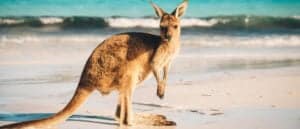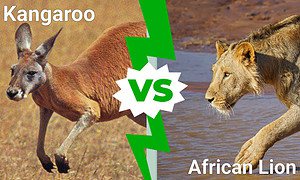Kangaroos are well known for their distinctive bounding gait. They are macropods, which literally means “big foot” and is particularly apt because kangaroos have extremely long and powerful hind legs. However, by contrast they have especially short and small forelimbs that are very similar to hands. Kangaroos have long, sharp claws on both their front and back feet, but why are they so long? And do they really have hands, or are they actually paws? Join us as we discover everything you’ve ever wanted to know about kangaroos hands, paws, and claws!
Do Kangaroos have Hands?
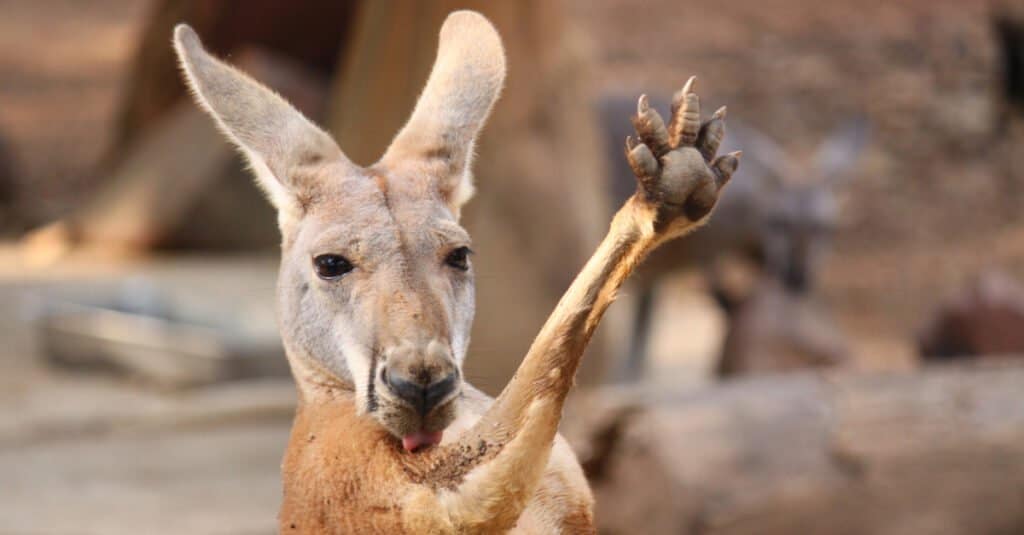
Kangaroos have front paws.
©Bioswinter/Shutterstock.com
Male kangaroos often engage in fierce and brutal boxing matches in a battle for dominance, and during those fights they punch, hit, and grasp each other around the neck with their front limbs. Therefore, it’s quite easy to assume that they actually do have hands. However, that’s not strictly true. Although they have a similar structure to our hands, they’re technically just small paws.
Kangaroos front paws have five toes and each toes ends in a long, curved claw. The underside has a course paw pad. Despite how similar they are to hands, kangaroos forepaws don’t have opposable thumbs. However, even though they don’t have thumbs they are still able to use them for a range of different things. Kangaroos use their front paws for eating, grooming, fighting, and crawl-walking.
What do Kangaroos use their Front Feet for?
Eating

Kangaroos use their front paws for holding food
©by Ester Inbar, available from https://commons.wikimedia.org/wiki/User:ST., Attribution, via Wikimedia Commons – License
As kangaroos stand upright on their hind feet they can keep their forepaws free to hold food with. Kangaroos are herbivores and eat a range of grass, leaves, flowers, and fruit. They use their front paws to hold or pull at leaves and branches while they are eating. Although they don’t have thumbs they can still manage to hold foliage sufficiently well. Incredibly, studies have shown that most kangaroos are actually left handed!
Grooming
An important part of a kangaroos life is grooming themselves. Kangaroos groom themselves by combing their coats with their claws. They also use their front paws to smear saliva on themselves. Kangaroos cannot sweat as they don’t have sweat glands. To help themselves keep cool they instead lick the inside of their forearms until their skin is wet with saliva and lick their front paws and smear the saliva on their chests. Kangaroos do this because in those areas the blood vessels are closer to the surface. When the saliva evaporates it cools down the blood in those areas which then circulates around the entire body, cooling the kangaroo down.
Crawl-Walking
Although kangaroos mostly move around on their long back legs, when they are grazing they use their forepaws as well. This is known as “crawl-walking” because the kangaroo literally appears to be crawling on their short forelegs. Crawl-walking is a much slower process than their hopping motion. Crawl-walking involves the kangaroo resting their forepaws on the ground and then bracing their tail on the ground (this is why it is often called their “fifth leg”). They can now support their weight on their tail and forepaws while they pull their hind legs forward slightly, put them down, move their forelegs, and repeat the process.

Crawl-walking is one of the things kangaroos use their forepaws for
©Benny Marty/Shutterstock.com
Fighting
Fighting plays a major role in the hierarchy of a kangaroo mob as males often fight for dominance and access to the females. Males take part in boxing matches, and during these fierce fights they use their forepaws to grapple with their opponent. Kangaroos grasp each others necks with their front paws and then proceed to punch and hit each other across the head and chest with them. As they’re doing this they use the long, curved claws on their paws to swipe at each other. Considering how sharp they are, it’s not surprising that they can do some serious damage with them.
As well as using their forepaws for fighting each other, kangaroos use them to kill their predators with. Although kangaroos often use kick and swipe at their predators with their front paws, they also use them to drown them with. If kangaroos are threatened by a predator, particularly dogs, then they often head for water. Once in the water they are known to turn on the predator and use their forepaws to hold them under the water and drown them.
Hind Paws
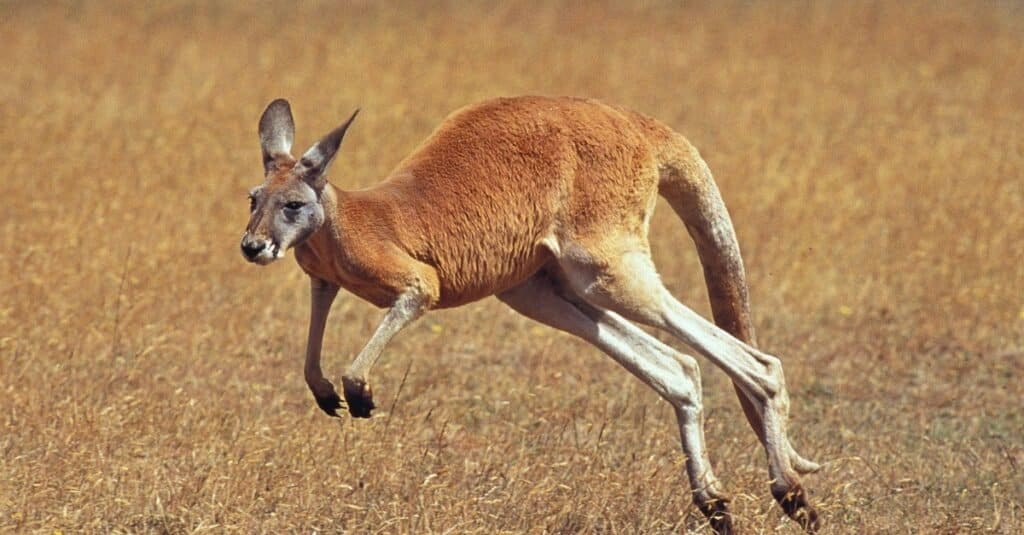
Hopping is the main purpose of the hind feet
©iStock.com/slowmotiongli
Kangaroos are famed for their large, powerful hind legs. Just like their front feet, kangaroos hind feet are actually paws and have tough paw pads on their underside to protect them while they’re hopping along for miles on end. However, their back paws have completely different toes to their front paws. Kangaroos have four toes on their back paws, but the middle two are fused together up to the claw. This is known as “syndactyly”. On the end of the two toes is a particularly long and powerful claw.
The main purpose of a kangaroos hind feet is movement. These large feet are uniquely adapted to their method of travelling – hopping. Kangaroos have Achilles tendons that run down their hind leg. These tendons basically act as a spring when they move their hind legs and gives them the momentum to hop with. Their long central toes that are fused together also aids their movement. The action of pushing their toes away from their bodies works with the energy generated from the tendons and ligaments and helps to give them to momentum to spring up off the ground. By using their hind legs and feet this way, kangaroos can jump great distances, both forward and vertically in the air. This means that they can cover a lot of ground quickly when travelling and also jump fences.
As well as using their hind paws for moving around, kangaroos use them as a warning system. If a kangaroo detects predators – such as dingoes, eagles, or foxes – then they stamp their large hind feet on the ground to warn the rest of the mob. This alerts them to the danger that is nearby and can prevent predators from sneaking up on other kangaroos.
Kick Boxing & Claws
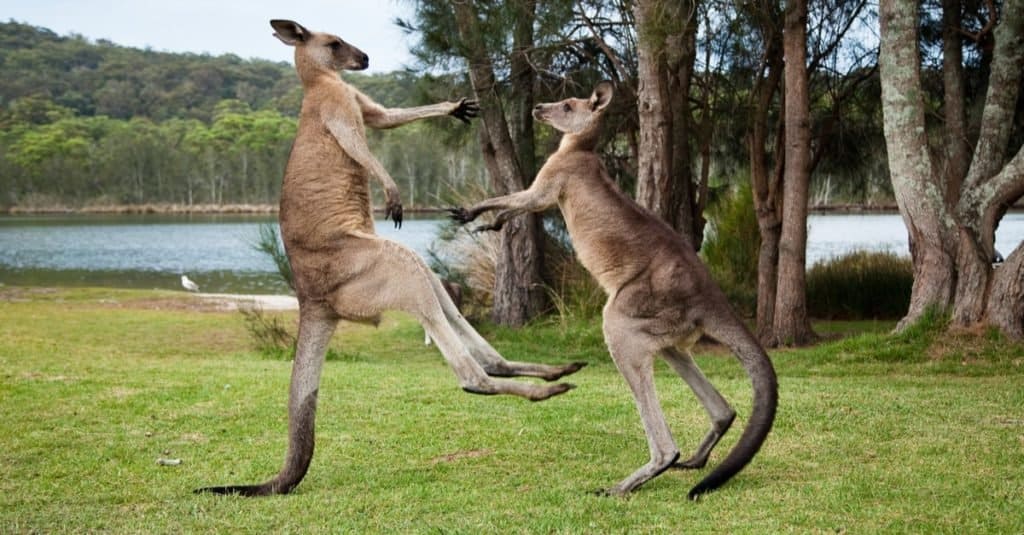
Kangaroos use their hind legs to kick box with. However, their long central claw can inflict serious damage
©Breathes/Shutterstock.com
As we’ve already mentioned, kangaroos have really sharp claws. Each toe on their forepaws has a long, curved claw. They also have three claws on each hind paw, with the central claw being the biggest and the longest. Easily the most important role that these hind claws play is in the ritualized boxing matches that males take part in. The claws on their hind paws are believed to be the most lethal as they can easily disembowel a kangaroo if they hit their mark.
When kangaroos box they perform a unique manoeuvre known as kick boxing. Kick boxing is where they balance on their long and muscular tail while they kick out at their opponent with their hind feet. When a kangaroo kicks out at its opponent they are often able to send them flying back because of the sheer amount of strength they have in their hind legs. However, when kangaroos do this also they utilise that large central claw. Although male kangaroos have thick, tough skin on their bellies to protect them from these hind claws during a fight, they often still do a lot of damage.
The photo featured at the top of this post is © Benny Marty/Shutterstock.com
Thank you for reading! Have some feedback for us? Contact the AZ Animals editorial team.





